This page was archived in 2023 as part of the Mac Hut archive and is no longer updated.Most of the site pages were last updated around 2004 and some information may be out of date. Various links may be broken. Become a patron: Support our efforts by contributing a small amount each month to cover our hosting costs and the time it takes to archive these pages properly. Thank you. |
The Macintosh Office
In 1984, Apple introduced the AppleTalk network, a self-configuring local area network technology.
In 1985, Apple introduced the Macintosh Office.
- LaserWriter printer
- AppleTalk Personal Network
- File server (no real product name I could find)
The Macintosh Office used simple connectors which plugged into the printer port on a Macintosh. The cable that linked to each Macintosh used the mini-din 3 connector. Three wires were used.
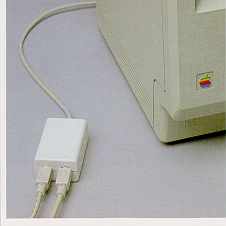
Here is a example of the connector boxes and cables which consisted of the mini-din 3.
• The cost was $50.00 per Macintosh.
• The ImageServer was planned to share the LaserWriter laser printers.
* This eventually became part of the AppleShare product, in version 2.01 there was a separate print server piece.
• The FileServer was planned to share files. This project was later canned.
* I wonder if this project was later turned into AppleShare.
Apple everntually did ship a different file server product called AppleShare. This was a dedicated file server.
Unfortunately the idea of the Macintosh Office never really took off in the office setting. In the printing setting, Desktop Publishing embraced the hardware and software.
Lemmings commercial
When The Macintosh Office was released to the public, a new commercial aired during SuperBowl XIX called "Lemmings" aired. This commercial featured many business people walking blindfolded, following each other over a cliff. The last person lifts the blindfold and looks back. The music is a rendition of Disney's Snow White "Hieigh-Ho" song.
Here are a few snippets -
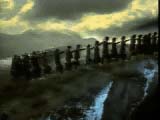
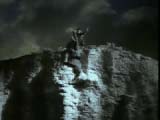
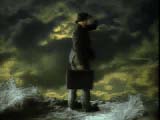
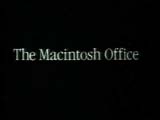
Unfortunately people did not have the same positive reaction like they did with 1984. Chat/Day does not have this commercial on their web page for you to download. :(
![]()
Here is a picture of an "typical" Macintosh office:
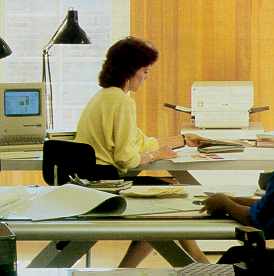
The Macintosh and LaserWriter, the LaserWriter was a shared piece of equipment. LaserWriters cost $6,995 in 1985.
What did take off is the Desktop Publishing revolution:
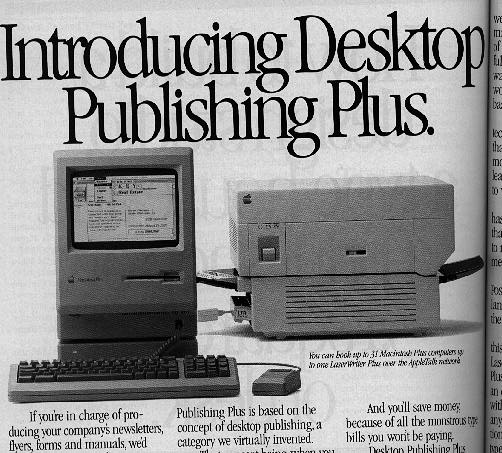
Desktop Publishing Plus incorporated the successful Macintosh Plus, LaserWriter Plus and an external hard drive.
The evolution of AppleTalk/LocalTalk?
AppleBus from "The Apple Macintosh Book" from Copyright 1984 by Cary Lu. Published by Microsoft Press.
The AppleBus system will not appear well into 1984. AppleBus uses a shielded, 78 ohm, twisted-pair cable, supporting 16 nodes over a total length of 100 feet (300 meters), terminated at both ends. A transformer isolates each device from the cable. Information travels in packets, or frames, similar to SDLC/HDLC communications.
The packets contain the addresses of the destination device in addition to data. So that only one device is sending a message and any given time, bus control is handled by a master device that polls the other devices ("slaves") periodically to determine if there is a message to be sent. A slave can send a message only after receiving permission from the master. The master keeps track of the activity of each slave and polls the active slaves more often than the inactive ones. The master device can be a server (such as an intelligent hard-disk drive, or a special device) or it can be a Macintosh or Lisa. Since being master takes some computing time that may detract from a computer's performance, mastership may pass from device to device.
If there is no activity for a period, the master stops polling and sends a "sleeping" message to the slaves, who then send a wakeup call instead of waiting for a pooling signal.
• AppleBus is a simple, low-cost network; many other types of networks will also support Macs and Lisas. Some can move data much faster then AppleBus, although the Macintosh will not be able to take full advantage of the speed because of hardware restrictions.
• Winchester disk drives can be attached to AppleBus. Several Macintoshes could share such drives.
AppleNet came up as a physical connection. I don't have more information on AppleNet.
AppleBus and AppleNet were also described as communication protocols, could AppleBus/AppleNet be AppleTalk/LocalTalk??
* I wonder if AppleBus was the same as AppleTalk or a more advanced version which accommodated hard drives...
Can someone provide some light on this?
02/1999 - MacWorld February 1985 issue, page 100 says "Apple's Network, which has been referred to as AppleBus for several months, had been renamed the AppleTalk Personal network. Each device in a network requires an AppleTalk cable connector set, which retails for $50.00."
I'm glad this mystery is over...
[ System Showcase ] [AppleTalk-ing ] [ Mac Resources ] [ Help ]
[ The Mac 512 Site Map ]
The Mac 512 is a gYounk design & programmed site.